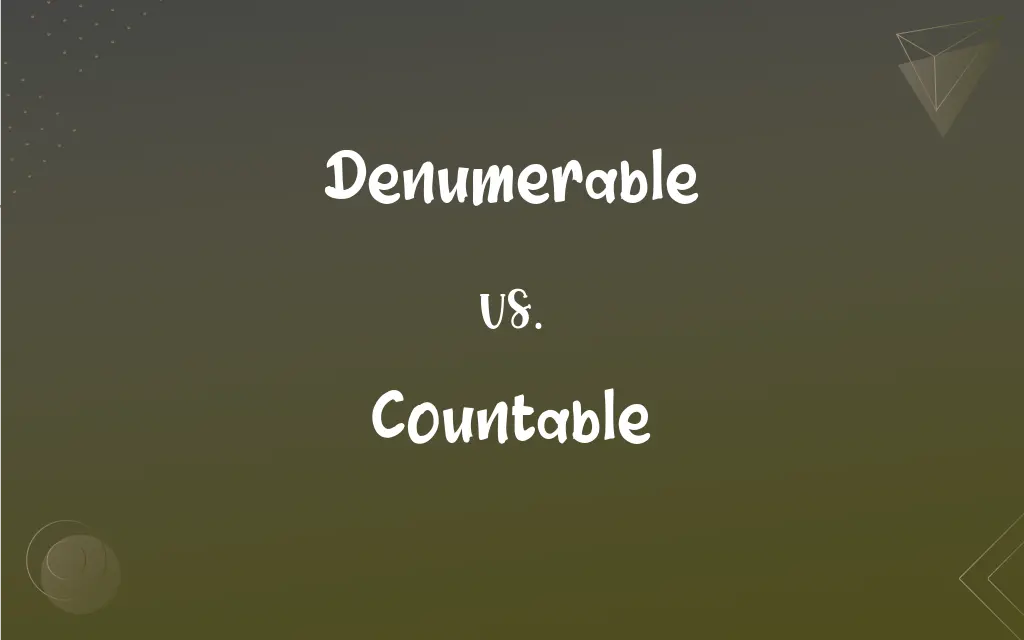Denumerable vs. Countable: What's the Difference?
By Aimie Carlson & Harlon Moss || Updated on March 4, 2024
Denumerable and countable sets are infinite sets that can be mapped to the set of natural numbers indicating they have the same cardinality as ℕ. The terms are often used interchangeably in mathematics to describe sets that can be listed in a sequence.

Key Differences
Denumerable sets are a subset of countable sets, specifically referring to infinite sets that can be put into a one-to-one correspondence with the set of natural numbers (ℕ). This implies that, despite their infinity, denumerable sets can be "counted" in the sense that each element can be matched with a unique natural number. Countable sets, on the other hand, include all denumerable sets and also possibly finite sets. A countable set is one that is either finite or has the same cardinality as the set of natural numbers, making all denumerable sets countable by definition.
The concept of denumerability is crucial in distinguishing between different sizes of infinity in mathematics. For example, the set of integers (ℤ) and the set of rational numbers (ℚ) are both denumerable, illustrating that not all infinities are of the same magnitude. Countable sets extend this notion by encompassing any set that doesn't surpass the cardinality of ℕ in terms of size, whether it's finite or infinitely large.
An important distinction arises in the context of uncountable sets, which cannot be mapped to ℕ due to their larger cardinality. The set of real numbers (ℝ), for instance, is uncountable, highlighting a key difference from denumerable and countable sets. While denumerable and countable sets are conceptually similar in that they can be sequentially listed, the inclusion of finite sets under the countable category broadens its scope beyond the strictly infinite nature of denumerable sets.
In practice, the terms denumerable and countable are often used interchangeably when referring to infinite sets that can be enumerated. However, the precise definition of countable sets as including both finite and denumerable sets allows for a broader classification of set sizes and their comparative analysis in the field of set theory.
Comparison Chart
Definition
Infinite sets that can be matched one-to-one with ℕ.
Sets that are either finite or can be matched one-to-one with ℕ.
ADVERTISEMENT
Cardinality
Same as ℕ, infinite.
Finite or the same as ℕ.
Example Sets
ℤ (integers), ℚ (rational numbers).
ℚ, ℤ, {1, 2, 3, ..., 10} (a finite set).
Relation to ℕ
Can be perfectly matched with natural numbers.
Can be perfectly matched with or is less than natural numbers in size.
Uncountable Sets
Cannot be denumerable.
Cannot be countable.
Key Characteristic
Strictly infinite with a one-to-one correspondence to ℕ.
Includes all denumerable sets and finite sets.
ADVERTISEMENT
Usage
Often used to describe infinite sets that are not too "large".
Used to describe any set that is not larger than the set of natural numbers.
Denumerable and Countable Definitions
Denumerable
Infinite sets that can be sequentially listed like natural numbers.
The set of all even numbers is denumerable.
Countable
Characterized by the ability to list elements in a sequence.
The set containing the first ten positive integers is countable.
Denumerable
Sets that do not exceed the cardinality of ℕ despite being infinite.
The set of integers is denumerable because it can be arranged in a sequence.
Countable
Can be applied to both finite and infinite sets without distinction.
The set of natural numbers itself is countable.
Denumerable
Applies to infinite sets only.
The set of all algebraic numbers is denumerable.
Countable
Reflects a size limitation relative to ℕ.
Any subset of natural numbers is countable, as it can be enumerated.
Denumerable
Characterized by having a one-to-one correspondence with ℕ.
Every prime number can be matched with a unique natural number, making the set of primes denumerable.
Countable
Includes both finite sets and denumerable infinite sets.
The set of all whole numbers is countable.
Denumerable
Reflects the concept of countably infinite.
The rational numbers are denumerable, illustrating countable infinity.
Countable
Capable of being counted
Countable items.
Countable sins.
Denumerable
Capable of being put into one-to-one correspondence with the positive integers; countable.
Countable
(Mathematics) Capable of being put into a one-to-one correspondence with the positive integers.
Denumerable
(mathematics) Capable of being assigned a bijection to the natural numbers. Applied to sets which are not finite, but have a one-to-one mapping to the natural numbers.
The empty set is not denumerable because it is finite; the rational numbers are, surprisingly, denumerable because every possible fraction can be assigned a natural number and vice versa.
Countable
Capable of being counted; having a quantity.
Denumerable
That can be counted.
Countable
Finite or countably infinite; having a one-to-one correspondence (bijection) with a subset of the natural numbers.
Denumerable
That can be counted;
Countable sins
Numerable assets
Countable
Countably infinite; having a bijection with the natural numbers.
Countable
Freely usable with the indefinite article and with numbers, and therefore having a plural form.
Countable
(grammar) A countable noun.
Countable
Capable of being numbered.
Countable
That can be counted;
Countable sins
Numerable assets
Countable
Sets that are either finite or have a one-to-one correspondence with ℕ.
The set of letters in the English alphabet is countable because it is finite.
FAQs
What makes a set denumerable?
A set is denumerable if it is infinite and can be put into a one-to-one correspondence with the set of natural numbers.
Can a finite set be countable?
Yes, a finite set is considered countable because its elements can be listed or matched with a subset of natural numbers.
Can you give an example of a countable set that is not denumerable?
Any finite set, such as the set of days in a week, is countable but not denumerable since denumerable sets must be infinite.
What is an example of an uncountable set?
The set of real numbers is an example of an uncountable set because it cannot be put into a one-to-one correspondence with the set of natural numbers, indicating a larger type of infinity.
Can the set of all real numbers between 0 and 1 be countable?
No, the set of all real numbers between 0 and 1 is not countable; it is an example of an uncountable set because there is no way to list all the numbers in this interval without missing any, as proven by Cantor's diagonal argument.
Are all infinite sets denumerable?
No, not all infinite sets are denumerable; some, like the set of real numbers, are uncountable because they cannot be matched one-to-one with ℕ.
How do denumerable sets differ from uncountable sets?
Denumerable sets can be matched with natural numbers, indicating a type of infinity that is "countable," whereas uncountable sets have a greater cardinality, making such a matching impossible.
Why are some sets considered countable and others not?
Sets are considered countable if they are either finite or their infinity does not exceed that of the natural numbers, making it possible to list their elements in sequence. Sets that surpass this size are uncountable.
Is the set of all rational numbers countable?
Yes, the set of all rational numbers is countable because it is denumerable; it can be arranged in a sequence that matches with natural numbers.
How is the concept of countability used in set theory?
In set theory, countability is used to classify sets, distinguish between different sizes of infinity, and explore the properties of sets within the framework of mathematical logic.
Why is the distinction between countable and uncountable sets important in mathematics?
The distinction is crucial for understanding the structure of sets, the foundation of measure theory, and the behavior of functions across different types of infinities, influencing fields such as analysis, probability, and topology.
What is the significance of a set being denumerable in mathematics?
Denumerable sets help mathematicians understand the concept of infinity, showing that some infinite sets can be "counted" in a manner analogous to counting natural numbers.
How do mathematicians prove a set is denumerable?
Mathematicians prove a set is denumerable by constructing a bijection (a one-to-one and onto function) between the set and the set of natural numbers, demonstrating that every element of the set can be paired with a unique natural number.
What is the difference between denumerable and countably infinite?
Denumerable and countably infinite are terms often used interchangeably to describe infinite sets that can be put into a one-to-one correspondence with ℕ. However, "countably infinite" explicitly emphasizes the infinite nature of the set, whereas "denumerable" might be used in contexts where the focus is on the set's ability to be enumerated like ℕ.
How does the concept of countability apply to the set of irrational numbers?
The set of irrational numbers is uncountable. While both rational and irrational numbers are infinite, the irrationals cannot be enumerated in a sequence that matches them with ℕ, unlike the rationals.
What makes a set uncountable, and can you provide an example?
A set is uncountable if it cannot be put into a one-to-one correspondence with the set of natural numbers, indicating a higher magnitude of infinity. An example is the set of real numbers (ℝ), which includes all the points on a continuous line.
What role does countability play in the development of mathematical theories?
Countability is foundational in several areas of mathematics, including analysis, where it distinguishes between different types of convergence and continuity, and in set theory, where it helps categorize sets and explore the nature of infinity.
Is the set of all algebraic numbers countable?
Yes, the set of all algebraic numbers is countable. Although it is infinite, there exists a way to enumerate all algebraic numbers, making the set denumerable.
What are the implications of a set being countable for its cardinality?
If a set is countable, its cardinality is either finite or equal to the cardinality of the set of natural numbers, denoted by aleph-null (ℵ₀), the smallest infinite cardinal number.
Can countability be extended to higher dimensions, like the set of points in a plane?
Yes, even in higher dimensions, concepts of countability apply. For example, the set of points with rational coordinates in a plane is countable, but the set of all points in the plane (ℝ²) is uncountable.
About Author
Written by
Aimie CarlsonAimie Carlson, holding a master's degree in English literature, is a fervent English language enthusiast. She lends her writing talents to Difference Wiki, a prominent website that specializes in comparisons, offering readers insightful analyses that both captivate and inform.
Co-written by
Harlon MossHarlon is a seasoned quality moderator and accomplished content writer for Difference Wiki. An alumnus of the prestigious University of California, he earned his degree in Computer Science. Leveraging his academic background, Harlon brings a meticulous and informed perspective to his work, ensuring content accuracy and excellence.































































